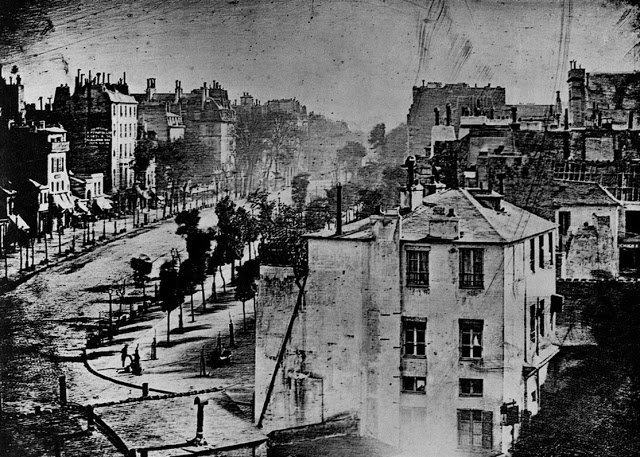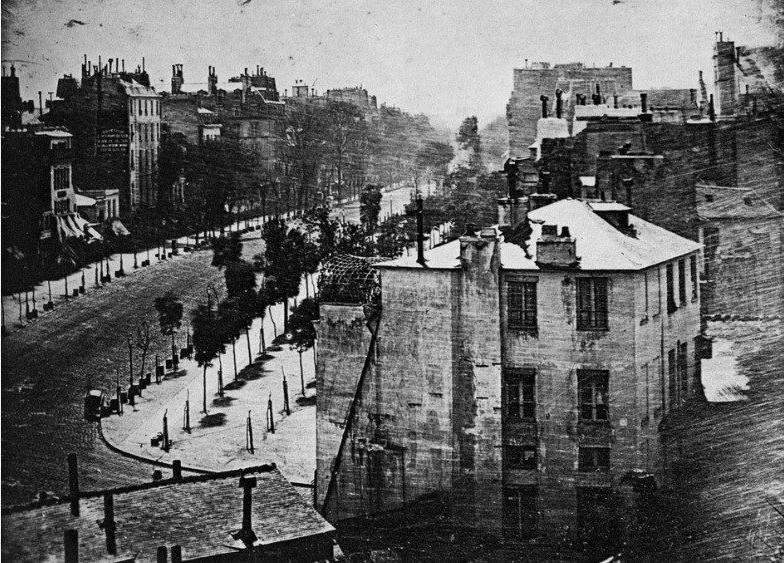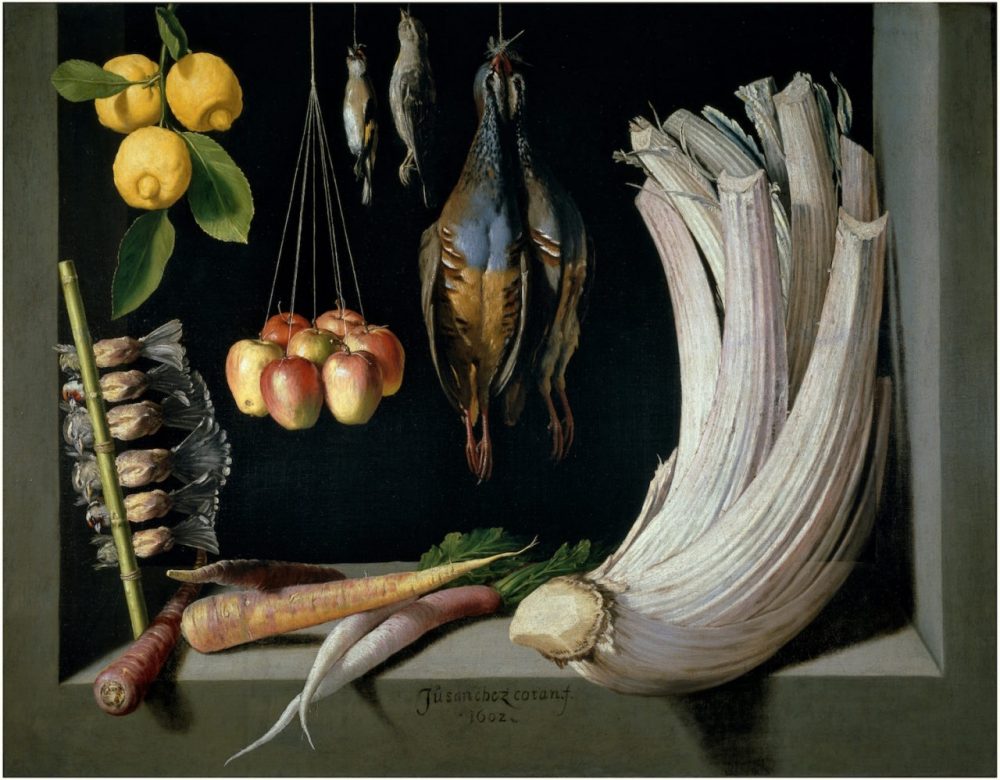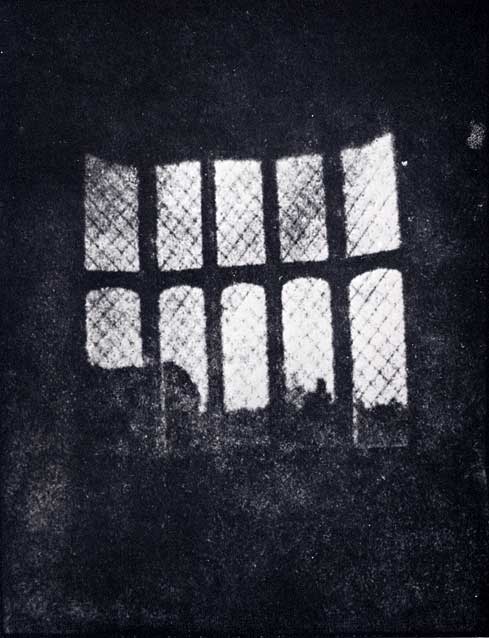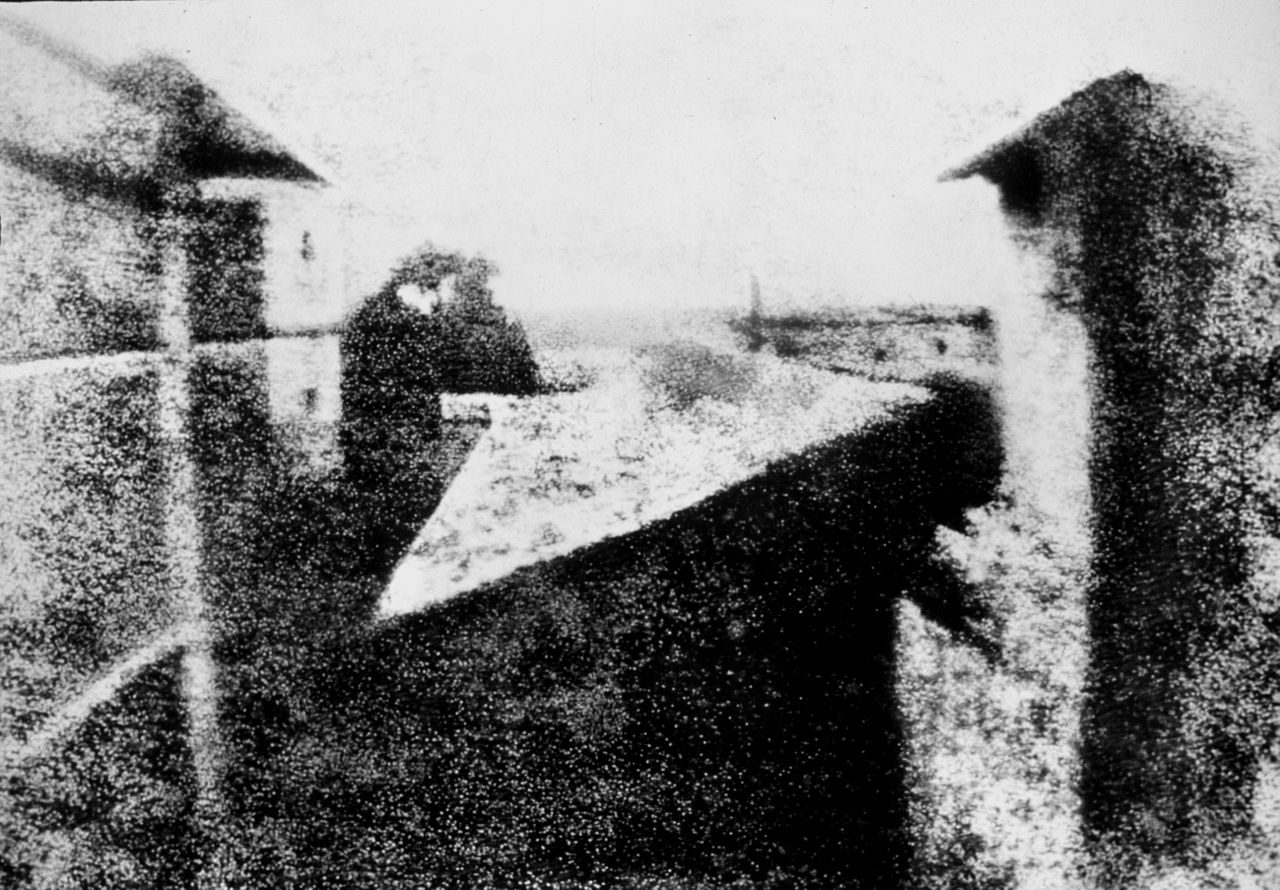
Series Photography was Born at the Window
Ch.1 The Battle for Realism
28 Mar 2019
- Keywords
- Essays
- Photography
The pioneers (1) Niépce and Daguerre
“I made a dissolution of silver nitrate, much diluted by water, in the same proportions as those indicated in the report above on Photographie, to which I also refer for those who have never made a silver solution in nitric acid. I wetted one side of a thin paper sheet; I laid it out at the back of the camera obscura1 by sticking it on its edges, to keep it flat. I placed the camera obscura vertically, opposite some houses in front of my window, in such a way that the lens was vertical; and by being parallel to it, the paper received the image in full. I left the camera obscura in that state for two hours, at the end of which I went to see, and I found that the silver nitrate had become brown in the places which had received light…”2
With these words, in October 1833, Hercule Florence describes his experiments. This is not just any text, but the one in which for the first time, the French pioneer (by then a naturalised Brazilian) coins the term by which this technique was to become known in the Western world: photography. Alas, no visible trace remains of the image he refers to, long lost along with his other experiments with the camera obscura due to the difficulty in fixing the results, but this may provide a starting point to investigate what seems to be an incontrovertible fact: photography was born at the window.
Besides Florence, in fact, the three main inventors of the various declinations of this procedure took one or more images from the windows of their own homes or studies: Joseph Nicéphore Niépce and Louis-Jacques-Mandé Daguerre in France, and William Henry Fox Talbot in Britain. In practice, to use the words which they themselves adopted to define their creations, their heliographs, daguerreotypes and calotypes were produced by positioning the camera obscura in front of a window. It cannot be a coincidence. There is a technical reason behind it: in the early days of these experiments, every shot had to be created with the abundant and prolonged exposure of light-sensitive materials, while at the same time it was best to protect clearly fragile and heavy equipment under a roof. The window could guarantee both these privileges: making it possible to exploit the power of the sun’s rays yet from the protection afforded by a closed space.
Nevertheless, this is not a sufficient explanation. Niépce, Daguerre and Talbot were learned men, and they were all too familiar with the visual arts (lithography the former, painting the second, and drawing and theoretical studies the latter) not to have noted the analogy between the two terms of this combination. Photography leads to the completion of the ideal expressed by Leon Battista Alberti in De Pictura (On Painting) 3 (1435-36), in which he formulates the first definition of perspective and describes painting as “a window open on the world.”
The scientific method, which allowed the Italian architect to approach perfection in his representation, is implicitly accompanied here in every shot. For the pioneers of this revolution, imbibed as they were in Romantic and positivist culture, the window must have appeared as the purest metaphor by which to describe the prodigious undertaking that was photography. Their very first images, whatever may be seen lying beyond the shutters, are (also) a representation of this undertaking.
-
When Alberti discussed the laws of perspective in his treatise De Pictura (On Painting), written in 1435, he compared painting to the act of looking through an open window—meaning that to paint in the Renaissance period was to depict the world as viewed through that window.
Joseph Nicéphore Niépce
Point de vue du Gras, 1827
The most ancient photographic image taken from real life and still with us was taken from a window. The image is the famous Point de vue du Gras by Joseph Nicéphore Niépce, obtained with e pewter support, bitumen of Judea as light-sensitive material and a mixture of lavender oil and turpentine serving as developing solution. This was the basic recipe for heliography, elaborated and corrected through countless attempts over the course of the years. While the image that we may still see to this day dates back to between June and July 1827, Niépce had been striving for a long time to capture and fix not only the results of generic experiments using the camera obscura, but always the same view from the window of his study. We know this thanks to the letters that Nicéphore exchanged with his brother Claude to keep him constantly up to date on his efforts.
On 5 May 1816, for example, he writes: “I placed the device in the room where I work in front of the pigeon loft, with the windows wide open, and I carried out the experiment following the procedure you are familiar with…”4 For more than ten years, therefore, more or less assiduously, Nicéphore Niépce focused his gaze and his lens on the same subject, carrying out both fundamental scientific research and a performance worthy of the most obstinate serial artist at the same time. Indeed, he tried to ensure his contraption would work in the same way as the window that lay before him: creating an opening on the world while automatically transforming it into an image.
The opening lines of his Notice sur l’heliographie immediately highlight this concept: “The discovery that I have made, and which I call by the name of heliography, consists in spontaneously reproducing – through the action of light and with the gradation of tones from black to white – the images displayed in the camera obscura.”5 Underlining the immediate and direct nature of his invention, Niépce also exhorts its extraordinary realism. In other words, as he states in a letter dated 20 August 1828: “Since my sole aim has become that of reproducing nature with the greatest fidelity, it is to this goal that I devote myself entirely…”6 “The thrill given by the loss of human control over the image”7 goes hand in hand with its verisimilitude, which in the heyday of positivism constituted the main criterion by which to assess the value of representation.
In Niépce’s heliography, there is everything he could see from the first floor of his home in Saint-Loup-de-Varennes, known as Le Gras: the pigeon loft, the pear tree, the roof of the barn in the foreground, the wood oven and its chimney. Everything is in its place, in the right proportions and with the semblances of reality. Or almost, because it was none other than the second protagonist of this story, Daguerre, who pointed out in a note dated October 1829 what he deemed to be the greatest defect of this image:8 “…the sun appears to have passed from right to left; that makes it impossible to render a natural effect.”9 The fact is that Niépce’s exposure time, given the scarce sensitivity of the materials used, was particularly long, estimable at around eight to ten hours, making it enough for the sun to move across the sky, casting light on opposite sides of the courtyard. The illusion of reality thus merges with the absurd. Outside Niépce’s window we find two suns.
Louis-Jacques-Mandé Daguerre
Boulevard du Temple, 1838
In all likelihood, Louis-Jacques-Mandé Daguerre’s attack on Niépce’s work was dictated by a combination of genuine concern for the loss of realism and more personal issues as well. Despite the fact they would soon become business partners (the agreement was signed on 14 December 1829 at Chalon-sur-Saône), the two were to all effects competitors in the perfecting of a revolutionary and potentially very remunerative invention, and so there is no doubt that they were both vying to gain a dominant position, especially the younger Daguerre, who knew he was in debt with regard to most of the main technical intuitions. It is equally clear that the issue of mimesis was an outright obsession for the latter, who before settling on photography had painted and financed major panoramas and dioramas10. As Gunthert writes, “as suggested by Daguerre, the question of the length of exposure times has to do first and foremost with an aesthetic issue, within the framework of realistic representation – an imperative aspect for a painter whose whole work was carried out under the aegis of the trompe-l’œil.”11
Opened in 1822 in a building constructed especially for the purpose, the Diorama belonging to Daguerre (and his business partner, Charles Bouton) offered displays of extraordinary illusionistic quality. Spectators would attend en masse to be magically cast into distant and magnificent scenarios and settings, from the midnight mass at Saint-Étienne-du-Mont to the ruins of Holyrood Abbey in Edinburgh, right up to Lake Sarnen in Switzerland. In order to increase the immersive effect, Daguerre would sometimes add real objects to the foreground (e.g. a real chalet, fir trees and even live goats in the case of a view of Mont Blanc), but the heart of the whole mechanism lay in the skilful use of a series of windows and skylights. The images were in fact painted on both sides of a great transparent screen (around 14 x 22 metres) which would be illuminated from various positions so as to make certain parts of it appear or disappear, to the point of alternating day and night.
In the same way, Daguerre interpreted photography in an essentially imitative and naturalistic manner, to the point that the daguerreotype technique actually provides much better results compared to heliography with regard to the description of the finest and most minute details of reality. In the wake of the unveiling of its working process, which took place on 7 January 1839 at the Académie des Sciences, the scientist Gay-Lussac referred to it in highly specific terms to the Chamber: “The Daguerreotype represents still life images to a degree of perfection unobtainable by the normal processes of drawing and painting: a perfection on a par with that of Nature herself.”12
The famous daguerreotype of Boulevard du Temple is very much along the lines of in this logic. Taken one spring morning in 1838, it is the result of a very special point of view: that from the window of Daguerre’s laboratory inside the diorama building at number 4 rue Sanson, right next to his atelier in rue des Marais. 13 A few metres away from the great room in which he would import views from every corner of the globe, Daguerre produced the panorama which, on the contrary, exported the image away from its place of origin, providing spectators with an equal yet contrary illusion. Like the previous image by Niépce, this too constitutes a record: it is the oldest photograph known to feature a human being, or as such it has gone down in history, for in actual fact there are four other daguerreotypes that might lay claim to the same title.14
In this case, there are at least two people in the image, tucked into the lower left-hand corner of the frame: a shoeshiner and his client. Whether Daguerre was aware of their presence or not is an equally debateable point. As Luigi Ghirri wryly recounts, “I reckon it’s a guy that Daguerre put there telling him to keep still for a few minutes… Some say it’s Daguerre himself who, after uncovering the lens, went down into the street and stood there for a while in that position.”15
On the other hand, there is also a much lesser known version of that image in which there is nobody to be seen, probably taken a little later. One thing is certain in both cases: that day, as always, the street was full of people, but their continuous movement prevented the plate from recording their silhouettes. Incredibly, the paradox of Niépce’s heliography is repeated. Despite the extraordinary refinedness of the result, what we see in the daguerreotype does not correspond exactly to what Daguerre could see from his window. The crowd bustling along the pavements of the city disappears here into the shadow of a row of trees. The hubbub has turned into silence. The real into the surreal.
Notes and works cited
1. Camera obscura (from the Latin for “dark room.”) is a projection device based on the principles of optics. When a pinhole is opened in a box that has been painted black, light that passes through that hole will form an image that projects on the opposite surface. This is the basic mechanism of the device. Because it produces an image with accurate perspective, it was sometimes used as a tool to aid artists when sketching.
2. Hercule Florence, Photographie ou Imprimerie à la lumière. Découverte nouvelle qui, par son extrême simplicité d’appareil et de procédé, met en tous lieux l’imprimerie entre les mains de tout le monde, manuscript, 22 October 1833. The manuscript is published in its entirety in Linda Fregni Nagler (ed.), Hercule Florence. Le Nouveau Robinson, Humboldt Books / Nouveau Musée National de Monaco, Milan/Monaco 2017, pp. 145-164.
3. Cf. Leon Battista Alberti, “De Pictura”, in Opere volgari, Cecil Grayson (ed.), vol. III, Laterza, Bari 1963.
4. Letter from Nicéphore Niépce to his brother Claude, 5 May 1816, in André Rouillé, La photographie en France: Textes & Controverses: une Anthologie 1816-1871, Macula, Paris 1989, p. 24.
5. The first version of the Notice sur l’héliographie dates back to 8 December 1827, when Niépce drew it up in Kew, UK, for the presentation of his procedure to the Royal Society. Here, reference is made to the second version of the same document, dated 24 November 1829 and published in Louis-Jacques-Mandé Daguerre, Historique et Description des procédés du daguerréotype et du Diorama, Alphonse Giroux, Paris 1839, pp. 39-46.
6. Letter from Nicéphore Niépce to Augustin Lemaître, 20 August 1828, in Helmut Gernsheim, Le origini della fotografia, Electa, Milan 1981, p. 21.
7. Roberto Signorini, Alle origini del fotografico. Lettura di The Pencil of Nature (1844-46) di William Henry Fox Talbot, CLUEB, Bologna 2007, p. 270.
8. Daguerre refers here to a later shot of the same subject, produced by Niépce in 1829 with a revised technique which allowed him to increase the contrast, blackening the uncovered parts of the plate with iodine vapour. The image in question bore the same defect (both sides of the courtyard were lit by the sun), and it was later lost.
9. Letter from Louis-Jacques-Mandé Daguerre to Nicéphore Niépce, 12 October 1829, in Torichtan Pavlovitch Kravets, Documentii po istorii izobretenia fotografii…, Academy of the Sciences of the USSR, Moscow, pp. 283-284.
10. A panorama was a large circular painting which provided visitors with a unique visual experience, using canvases painted with landscapes and displayed on the walls of a cylindrical building, which are gently rotated to make visitors feel as if they are actually immersed in the scenes. Daguerre apprenticed in panorama painting to the first French panorama painter Pierre Prévost, and later originated the idea of dioramas.
11. André Gunthert, La Conquête de l’instantané. Archeologie de l’imaginaire photographique en France (1841-1895), PhD Dissertation, Université Paris I, 2004, p. 49. Cf. Caroline Chik, L’image paradoxale. Fixité et mouvement, Presses Universitaires du Septentrion, Villeneuve d’Ascq 2001, pp. 47-48.
12. In Helmut Gernsheim, Le origini della fotografia, Electa, Milan 1981, p. 29.
13. Cf. Helmut & Alison Gernsheim, L. J. M. Daguerre: The History of the Diorama and the Daguerreotype, Dover, New York 1969.
14. Reference is made to the following materials: a daguerreotype by Daguerre of a view of Pont Neuf, held at the Musée des Arts et Métiers in Paris, in which two people may be seen lying at the foot of the equestrian statue of Henry IV, probably maintenance workers; a portrait of M. Huet (probably the painter Nicolas Huet) attributed to Daguerre by a number of scholars and held in the private collection of Marc Pagneux; two male portraits bearing Daguerre’s signature on the back, held at the Bibliothèque Nationale de France.
15. Luigi Ghirri, Lezioni di fotografia, Quodlibet, Macerata 2010, pp. 116-117.
Francesco Zanot
A photography critic and curator, Zanot has curated exhibitions and written catalog publications with many international photographers. In recent years he has curated books dedicated to artists such as Mark Cohen, Guido Guidi, Olivo Barbieri, Luigi Ghirri, Takashi Homma, Linda Fregni Nagler, Francesco Jodice, Boris Mikhailov, as well as Erik Kessels’s last retrospective The Many Lives of Erik Kessels. Together with Alec Soth, he is the author of the essay Ping Pong Conversations. irector of the Master in Photography organised by the NABA, Milan, he has given classes, conferences and lectures in numerous academic institutions, among them the Columbia University, New York, ECAL, Lausanne, and IUAV, Venice.
